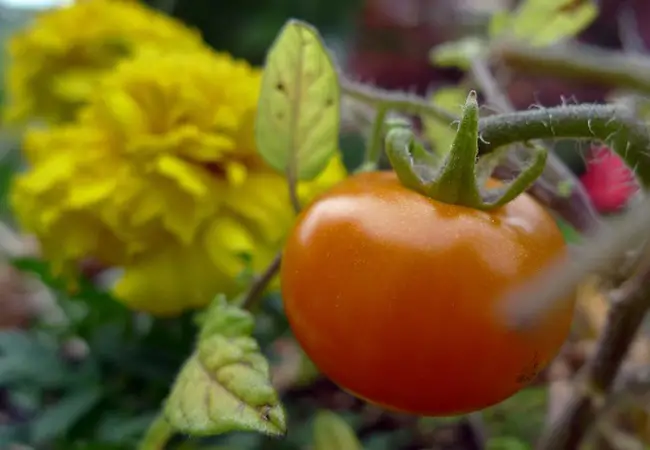As I was tending to my garden recently, I came across a marigold plant growing beside the tomatoes. I noticed that it had an impact on the health of the vegetables. This got me thinking; do marigolds really improve the way a tomato plant grows?
So what effect do marigolds have on tomato plants? As it turns out, they serve as great companions for a lot of plants, including tomatoes. Marigolds and tomatoes share similar conditions for growth.
More importantly, marigolds protect tomato roots from harmful nematodes present in the soil. They also deter beetles from harming the fruit.
Vegetables and fruits are usually the hardest to grow in a garden. You have to ward against many things constantly, and even then, it isn’t easy to know for sure if they will grow to resemble the produce we buy in the supermarket.
Those who’ve tried will know. People are constantly on the lookout for tips and tricks to help them maintain a healthy and beautiful garden.
This article provides some interesting observations to help you do just that with your fruits and vegetables, specifically tomatoes.
How do marigolds help tomato plants grow better?
Marigolds are one of the most beautiful varieties of flowers available. Ranging from bright yellow to orange and some shades of red, they grow in several green pastures from the beginning of summer until autumn.
While most of us are mesmerized by the beauty, only those with an avid interest in gardening know that the benefits of marigold go beyond just uplifting the colors in the field.
Marigolds have been considered an amazing companion plant for many years now. Farmers worldwide use them to protect their fruit and vegetable plants, particularly from different pests and destructive micro-organisms.
Scientists have carried out numerous researches, and it has been found that marigolds are effective at keeping root-knot nematodes at bay.
Root-knot nematodes are microscopic parasites that live in the soil and infect the parts of a plant buried in the ground. They commonly attach themselves to the roots of potato plants and cause inflammations that can be almost an inch wide.
This causes stunted growth, discoloration, and gradual death of the plant. Marigolds are effective at preventing these micro-organisms from reaching the roots of the tomato plant.
Marigolds act as trap crops for these nematodes. Their roots produce substances that can effectively limit the growth and infestation of these pests.
Planting marigolds as a cover for your tomato crops means that they will attract the worms towards the roots of the former. The plant can then kill them using the chemicals which are produced by its roots.
While this does not guarantee a completely pest-free environment, it goes a long way in limiting their spread to a great extent. Farmers and gardeners also believe that the pungent smell from these plants acts as a deterrent for bigger insects like bugs, whiteflies, and even bigger creatures like birds or rabbits.
Read also: Tips on Growing Tomatoes.
Why do marigolds serve as good companion plants?
There is no doubt that marigolds work amazingly with tomatoes, but there is evidence to suggest that they can provide the same level of protection to other crops. If you are a keen gardener who grows fruits and vegetables regularly, there are chances that you will have witnessed this. If not, be sure to give it a careful try.
The French marigold is considered the best variety to accompany some plants like potatoes, kale, broccoli, eggplant, and squash, among numerous others. Mexican marigolds are also great companion plants, but the French variation is the weapon of choice.
Gardeners believe that the strong smell of the marigolds masks the vegetables you are growing, therefore keeping harmful animals at a safe distance.
There is no denying the fact that marigolds are beautiful. The vibrant and attractive colors they add to the garden are refreshing to the eyes, especially during the spring. They are also very low on maintenance which means that they will last a long time without causing any severe problems.
They are one of the few plants which produce nematode-killing substances in their roots. This, coupled with the strong smells that are repulsive to animals, means that they have a sound defense mechanism.
Another benefit of planting marigolds as a companion plant is that they offer a helping hand in pollination. How do they do that, you may ask? The answer is that they attract bees which gardeners know are one of the most effective agents for spreading seeds from flowers and other plants over large areas.
Marigolds have been in use as a companion plant for many years now. They have been practically proven to deliver results not only in uplifting the overall feel of the garden but well beyond that. The protection that they provide against a diverse range of threats is incredible. From beetles to rodents, there are little known harmful agents which can beat them.
Marigold Tomato Variety
Marigolds, belonging to the genus Tagetes, is a flower that comes in several different varieties. They are classified based on the regions they are native to, the colors they grow, and other factors. The most common color that we have come across is obviously the yellow and orange varieties, but it is hard to believe that there are red, pink, and even white marigolds growing worldwide.
However, it is quite important to point out that not all of these varieties are suitable as companion plants, especially not for tomatoes. Not all kinds of marigolds perform the same functions as those recommended to be planted alongside tomatoes or other vegetables. For instance, only one or two types of these flowers produce the necessary chemicals to kill and repel nematodes.
French marigolds are one of the select few types which are known to produce these substances. While the Mexican variety of these flowers comes in as a close second choice, most gardeners prefer to go with the French. If you are new to the world of gardening and are considering planting marigolds next to your tomato plants, you should start with the French too.
The French variety of this flower is part of the shorter family of marigolds. Not only are they spectacular when growing in a bunch, but they also bring along the enormous benefits in protection that have been highlighted throughout our earlier discussion.
One of the main reasons why gardeners believe they have found a truly amazing companion plant in French marigolds is because of the ease with which they grow.
All that has to be done to grow marigolds is to plant the seed and make sure it gets adequate water and sunlight. Once they grow to their normal height, which is between 8 and 42 inches, these flowers become extremely sturdy and survive harsh circumstances. Marigolds are believed to be able to withstand close to droughts like conditions and still blossom.
What should not be planted with tomatoes?
This is one of the most interesting questions to answer. That’s partly because gardeners and farmers differ on the exact plants that don’t go well with tomatoes. More importantly, most vegetables that are good companions for marigolds are bad neighbors to tomatoes. Cabbages and all their relatives like broccoli, kale, and cauliflower are a big no, no for tomatoes.
Other plants that stunt tomatoes’ growth or cause other damages include corn, eggplants, potatoes, and peppers. Corns are dangerous companions for tomatoes because the worm that infects them is the same as the tomato fruitworm, also called the cotton bollworm. This means that if the plants are growing together, a feast has been laid out for these insects.
Mature dill plants also begin to hamper tomato growth. Brinjals, more commonly known as eggplant, potatoes, and peppers, are nightshade crops. Although the origins of the name are unclear, it is believed that since some of these plants grow in places with low sunlight and some flower at night, the name seems appropriate.
The matter is that they are vulnerable to blight if they are planted in the soil again and again for several years. Planting tomatoes near these plants can cause the disease to transfer and destroy the crop.
Walnuts, specifically black walnuts, are the ones that produce chemicals that are harmful to tomato growth. These also give rise to walnut wilt. Now you may be wondering what these crops are not compatible with each other, but they are good companions for marigolds.
So, what if these plants are placed in sync? You plant tomatoes, marigolds and then potatoes or cabbages or any other vegetable that you like. Well, there are a few problems with this.
Firstly, plant roots spread far and wide. It isn’t easy to control their growth because they will extend to the areas where they think the best concentration of nutrients is available.
This means that if potatoes are planted close to a tomato plant, the roots can spread and still pose as a fungus threat to the tomato plant.
Secondly, marigolds are not powerful enough to protect several plants from harmful impacts at the same time. Lastly, this type of plantation can destroy the soil by making it a breeding ground for pests and harmful for any fruit, vegetable, or even flower in the future.
Do marigolds repel tomato worms?
Yes, they do and are quite good at it too. We have seen in great detail how marigolds are amazing protection against nematodes, but they offer the same type of cover against common worms which threaten tomato plants like thrips and hornworms. Marigolds use the secretion from their roots to protect the soil and the scent from the flowers to cover the air.
Hornworms and moths are considered one of the biggest threats to a tomato plant. They are given the name because they love to feed on the nectar of the fruit of the tomato plant. These pests in a small quantity can run havoc on your crops if they are not dealt with effectively.
Although pesticides can also limit their reach to the plants you are growing, we all know that these chemicals can have other detrimental consequences.
Marigolds and their strong repulsive odor are quite significant at keeping tomato worms away from the flowers and the vegetable crop. This is also great for protection against other predators which might try and damage the plant.
Again, this scent is more commonly found in the two varieties of marigolds which come in recommended as companion plants to tomatoes, i.e., French and Mexican.
Some people also recommend keeping wasps to keep these harmful moths at bay, but this can become a problem for someone maintaining a home garden. Moreover, when you have plants like marigolds to do the job for you, little else might be required.
Of course, they will still require some care on your end, but it will not be as extensive as it would be without the marigolds.
How to grow marigolds with tomato plants
You have to bear a few things in mind while planting marigolds between or close to potato plants. The first is distance. It is recommended to plant the flowers at least 18 or 2 inches away from the tomato. This allows both the plants to have enough space to benefit from one another and not harm them in any way.
You can plant both of these simultaneously but make sure that initially, you water the seeds inside the soil. Marigolds are quick to spread, so that you can plant lots of them at closely calculated intervals.
While they won’t call for that frequent maintenance but you will have to trim the bushes regularly. Otherwise, the marigold bush will grow out of control and overcrowd the tomato, restricting its growth.
One important aspect to bear in mind when growing marigolds is watering. While they are popping out from the seeds, these flavors do not cope well with soggy soils.
If you water the ground too often, the flowers may not grow at all. Ensure that you keep an interval between watering, which allows the ground to dry to a certain level. The beginning of the day is the best time to water the plants.
Final word
Many people argue that marigolds and tomatoes being amazing companions is just a myth. Practical evidence proves otherwise. For many years, gardeners and farmers have used these flowers to protect their crops, and some studies also establish the scientific credibility of the phenomenon.
So, if you are a person growing tomatoes in your garden, you can try planting marigolds to help you relieve some of the tension that might arise from caring for these plants. Just make sure that you don’t overdo it.
Read also: Best Method Of Growing, Harvesting, and Caring of Strawberries




can i plant marigold under an apple tree
Yes, you can. Marigold can be an apple tree companion that helps to deter pests and enrich the soil when cutting back and left as mulch.